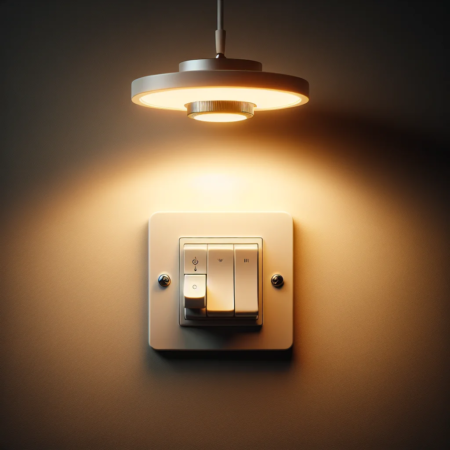Contents
Common Causes of Flickering Ceiling Lights
Loose light bulbs
Flickering ceiling lights can often be attributed to loose light bulbs. If the light bulbs are not securely screwed into the socket, it can cause intermittent flickering.
This is a common issue that can easily be remedied by ensuring that the light bulbs are firmly and properly installed.
Incompatible light bulbs with dimmer switches
Another frequent cause of flickering ceiling lights is the use of incompatible light bulbs with dimmer switches. LED light bulbs, in particular, may not be compatible with certain types of dimmer switches, leading to flickering issues.
It is essential to verify the compatibility of the light bulbs with the dimmer switches to prevent this problem.
Loose connections in the electrical system
Loose connections in the electrical system can also result in flickering ceiling lights. These loose connections can occur at various points in the electrical setup, from the light switch to the circuit breaker.
Identifying and tightening these loose connections is crucial in eliminating the flickering of ceiling lights.
Power supply issues
Issues with the power supply, such as fluctuations or inadequate electrical supply, can lead to flickering ceiling lights. Insufficient power reaching the light fixtures can cause flickering as the lights struggle to maintain a consistent brightness.
Assessing the power supply and ensuring it meets the requirements for the lighting fixtures is essential to address this issue.
Steps to Fix Flickering Ceiling Lights
To fix flickering ceiling lights, first turn off the power before touching any bulbs. Tighten the bulb in the socket or replace it with a new one if necessary. Check the compatibility of light bulbs with dimmer switches and upgrade to dimmable LED bulbs if needed. Inspect and secure any loose electrical connections and consult with a professional electrician if there are underlying power supply issues.
Is it important to turn off the power before touching light bulbs? Yes, it is important to turn off the power before touching any light bulbs to ensure safety.
Should you consult with a professional electrician for underlying power supply issues? Yes, it is advisable to consult with a professional electrician for underlying power supply issues for a thorough assessment and appropriate measures to be implemented.
Tightening or replacing light bulbs
To fix flickering ceiling lights caused by loose or faulty light bulbs, first ensure the power is turned off before touching any bulbs. Then, carefully tighten the bulb to ensure it’s properly seated in the socket. If the issue persists, replace the bulb with a new one to eliminate potential defects causing the flickering.
Checking and upgrading light bulb compatibility with dimmer switches
When encountering flickering ceiling lights with dimmer switches, it’s crucial to verify the compatibility of the light bulbs. Look for dimmable LED bulbs that are specifically designed to work with dimmer switches. Consult the manufacturer’s guidelines to ensure proper compatibility and consider upgrading to LED-compatible dimmer switches if necessary for a seamless lighting experience.
Identifying and fixing loose electrical connections
Flickering ceiling lights can often stem from loose electrical connections. To tackle this, inspect the wiring connections and ensure they are securely fastened. Utilize wire nuts and confirm they are tightly secured to maintain a stable electrical connection. If there are any loose connections, apply electrical tape to reinforce the wiring and prevent flickering issues.
Consulting with an electrician for power supply issues
For persistent flickering ceiling lights stemming from underlying power supply issues, it’s advisable to seek professional assistance from a qualified electrician. An electrician can conduct a thorough assessment of the electrical circuitry to pinpoint any power supply irregularities. They can then implement appropriate measures to rectify the power supply issues and ensure stable performance of the ceiling lights.
Remember, safety is paramount in any electrical work, so always exercise caution and consider professional help for complex issues.
Question: How do I fix flickering ceiling lights?
To fix flickering ceiling lights, start by ensuring that the bulbs are tightly screwed into their sockets and consider replacing them with high-quality, compatible ones. Check the wall switch for signs of wear or loose wiring, and consider replacing it with a new, reliable switch. Examine the entire electrical system for loose connections, damaged wires, or voltage irregularities, and seek professional assistance if needed. Consider upgrading to LED lighting for a more stable and long-lasting solution. If the issue persists, consult a licensed electrician for expert diagnosis and resolution.
Flickering Lights – Common Causes and Solutions
When dealing with flickering ceiling lights, it’s important to first understand the common causes and then move on to step-by-step solutions for fixing the issue. Let’s explore some of the key culprits and the respective remedies.
Step 1: Ensure Proper Installation of Bulbs
Loose or improperly installed bulbs can often be the root cause of flickering lights. Make sure all bulbs are tightly screwed into their sockets, as loose connections can lead to intermittent flickering. If the problem persists, consider replacing the bulbs with high-quality, compatible ones to ensure a secure fit.
Step 2: Examine the Wall Switch
An old or faulty wall switch can also trigger flickering lights. Take a closer look at the wall switch to check for signs of wear or loose wiring. Consider replacing the switch with a new, reliable one to stabilize the electrical connection and eliminate the flickering.
Step 3: Check for Electrical System Issues
Flickering lights can also stem from wider electrical system issues such as loose wiring or voltage fluctuations. It’s crucial to inspect the entire electrical system for any signs of loose connections, damaged wires, or voltage irregularities. If any abnormalities are detected, it’s recommended to seek professional assistance to rectify the underlying electrical problems.
Step 4: Upgrade to LED Lighting
Consider upgrading to LED lighting, as LED bulbs are known for their stability and longevity. LED bulbs are less prone to flickering compared to traditional incandescent or CFL bulbs, offering a reliable lighting solution while also reducing energy consumption.
Step 5: Seek Professional Electrician Help
If the flickering issue persists despite thorough inspection and troubleshooting, it’s advisable to consult a licensed electrician. Professional electricians possess the expertise and equipment to diagnose complex electrical issues and implement effective solutions, ensuring the safety and longevity of your lighting system.
By addressing common causes of flickering lights through meticulous examination and targeted remedies, you can effectively resolve this nuisance and restore consistent, reliable lighting in your home.
Ensuring prompt and correct attention to flickering ceiling lights is crucial for maintaining a safe and functional environment in your home. Addressing this issue promptly can help prevent potential electrical hazards and even fire risks.
It is important to understand the common causes of flickering lights and take necessary steps to rectify the problem.
One of the key reasons for addressing flickering ceiling lights promptly is to mitigate the risk of electrical fires. Ignoring flickering lights can lead to severe electrical issues, potentially putting your home and family in danger.
By promptly attending to flickering lights, you can prevent the escalation of electrical problems, ensuring the safety of your home.
Furthermore, flickering lights could be indicative of underlying electrical wiring issues that require immediate attention. Ignoring these signs might exacerbate the problem and lead to more complex and expensive repairs in the future.
By promptly and correctly addressing flickering ceiling lights, homeowners reduce the likelihood of encountering extensive electrical issues in the long run, saving both time and money.
Timely and appropriate action in response to flickering ceiling lights is essential for maintaining a safe and functional living environment. By understanding the causes of flickering lights and promptly addressing the issue, homeowners can safeguard their homes from potential hazards and ensure the smooth operation of their electrical systems.





